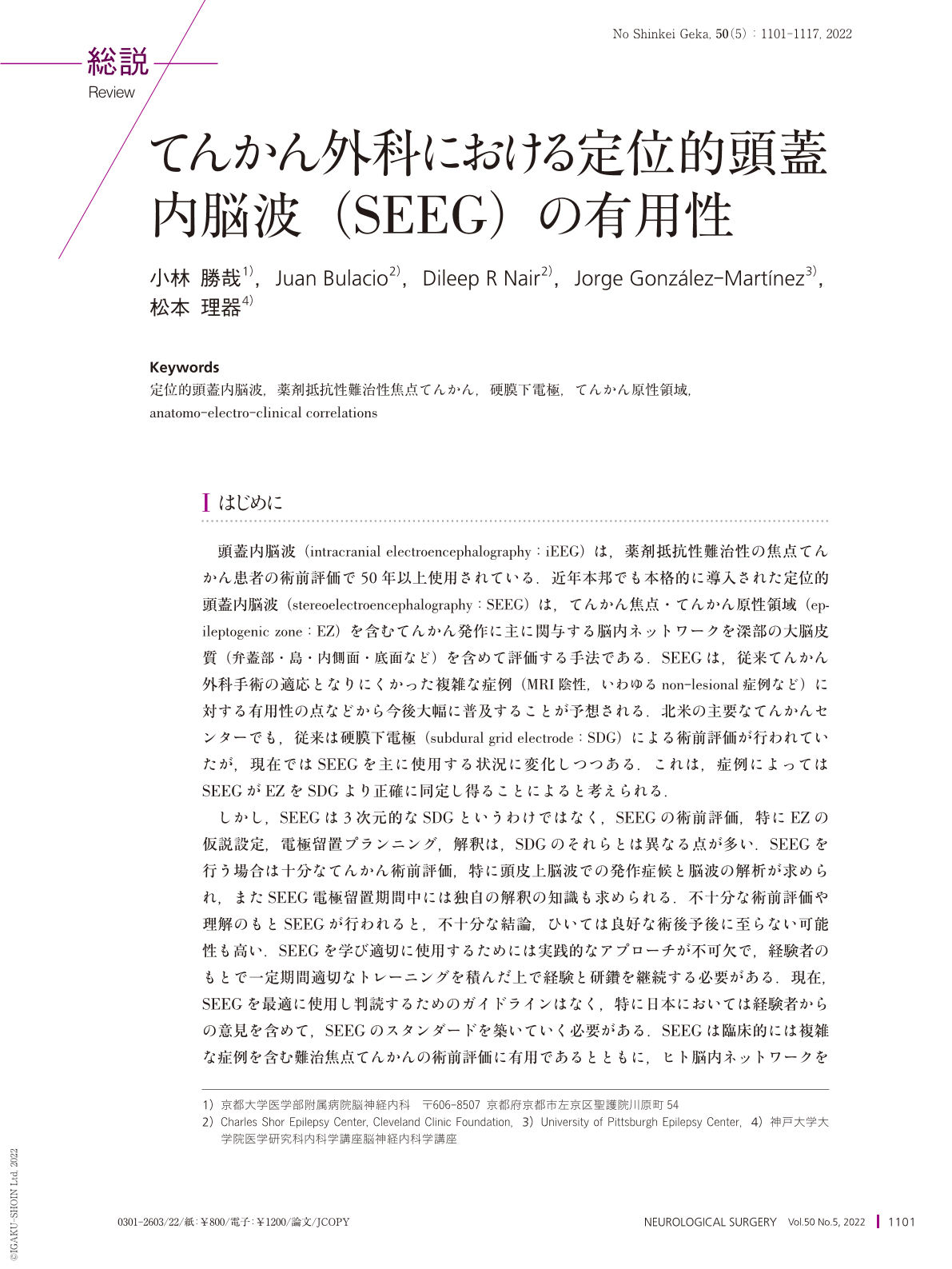Japanese
English
- 有料閲覧
- Abstract 文献概要
- 1ページ目 Look Inside
- 参考文献 Reference
Ⅰ はじめに
頭蓋内脳波(intracranial electroencephalography:iEEG)は,薬剤抵抗性難治性の焦点てんかん患者の術前評価で50年以上使用されている.近年本邦でも本格的に導入された定位的頭蓋内脳波(stereoelectroencephalography:SEEG)は,てんかん焦点・てんかん原性領域(epileptogenic zone:EZ)を含むてんかん発作に主に関与する脳内ネットワークを深部の大脳皮質(弁蓋部・島・内側面・底面など)を含めて評価する手法である.SEEGは,従来てんかん外科手術の適応となりにくかった複雑な症例(MRI陰性,いわゆるnon-lesional症例など)に対する有用性の点などから今後大幅に普及することが予想される.北米の主要なてんかんセンターでも,従来は硬膜下電極(subdural grid electrode:SDG)による術前評価が行われていたが,現在ではSEEGを主に使用する状況に変化しつつある.これは,症例によってはSEEGがEZをSDGより正確に同定し得ることによると考えられる.
しかし,SEEGは3次元的なSDGというわけではなく,SEEGの術前評価,特にEZの仮説設定,電極留置プランニング,解釈は,SDGのそれらとは異なる点が多い.SEEGを行う場合は十分なてんかん術前評価,特に頭皮上脳波での発作症候と脳波の解析が求められ,またSEEG電極留置期間中には独自の解釈の知識も求められる.不十分な術前評価や理解のもとSEEGが行われると,不十分な結論,ひいては良好な術後予後に至らない可能性も高い.SEEGを学び適切に使用するためには実践的なアプローチが不可欠で,経験者のもとで一定期間適切なトレーニングを積んだ上で経験と研鑽を継続する必要がある.現在,SEEGを最適に使用し判読するためのガイドラインはなく,特に日本においては経験者からの意見を含めて,SEEGのスタンダードを築いていく必要がある.SEEGは臨床的には複雑な症例を含む難治焦点てんかんの術前評価に有用であるとともに,ヒト脳内ネットワークを評価する研究的手法でもあり,今後の脳病態および神経科学の領域の発展に寄与する新たな手法と考えられる.本稿では,SEEGを実践する上で有用と思われる基本的事項,特に症例選択,仮説設定,電極留置プランニングについて概説する.またSEEGの脳波解析について,実際の症例を用いて紹介する.
Precise localization of the “epileptogenic zone(EZ)” is the goal of presurgical investigations in patients with drug-resistant focal epilepsy. Intracranial electroencephalography recordings are required when noninvasive evaluation results are not consistent. Although subdural grid electrodes(SDG)have been widely used in Japan, stereoelectroencephalography(SEEG)has been recently introduced. The principle of SEEG is based on anatomo-electro-clinical correlations to investigate surgical hypotheses that are primarily driven by the analysis of seizure semiology as well as other noninvasive investigations. The most important element of the SEEG methodology is to formulate preimplantation electrode trajectories considering the anatomo-electro-clinical correlations of epileptic seizures. If the preimplantation hypotheses are insufficient or incorrect, SEEG recordings will not identify the EZ. A detailed analysis of seizure semiology with respect to anatomo-electro-clinical correlates, particularly including various deep structures, such as the insular, operculum, and cingulate cortex, forms the basis of the implantation strategy for SEEG. The strategy of implantation is not to map the lobes/lobules but the epileptic networks, which usually involve multiple lobes, indicating that the theory of SEEG is completely different from that of SDG. Herein, we introduce the basics of SEEG, especially presurgical evaluations, with a representative case presentation.

Copyright © 2022, Igaku-Shoin Ltd. All rights reserved.


